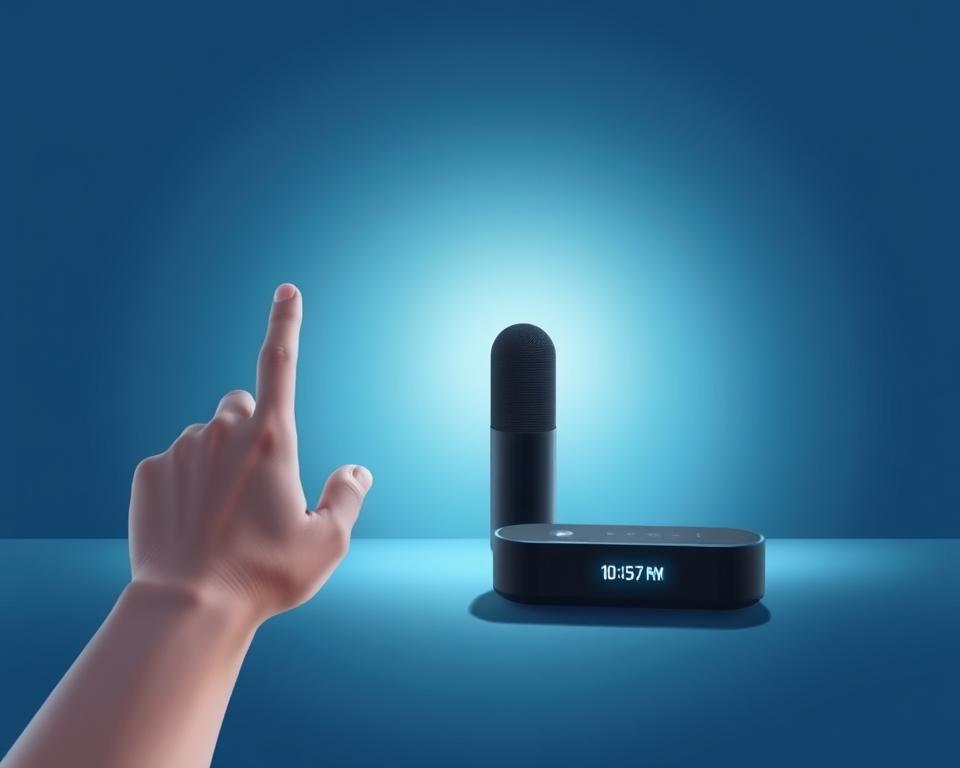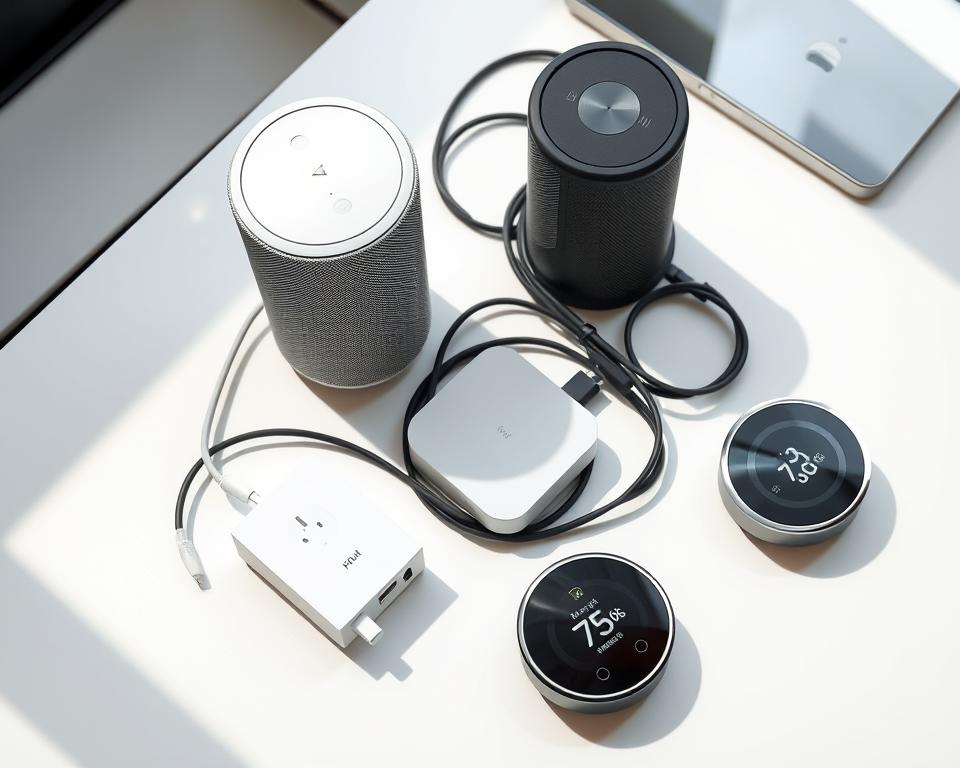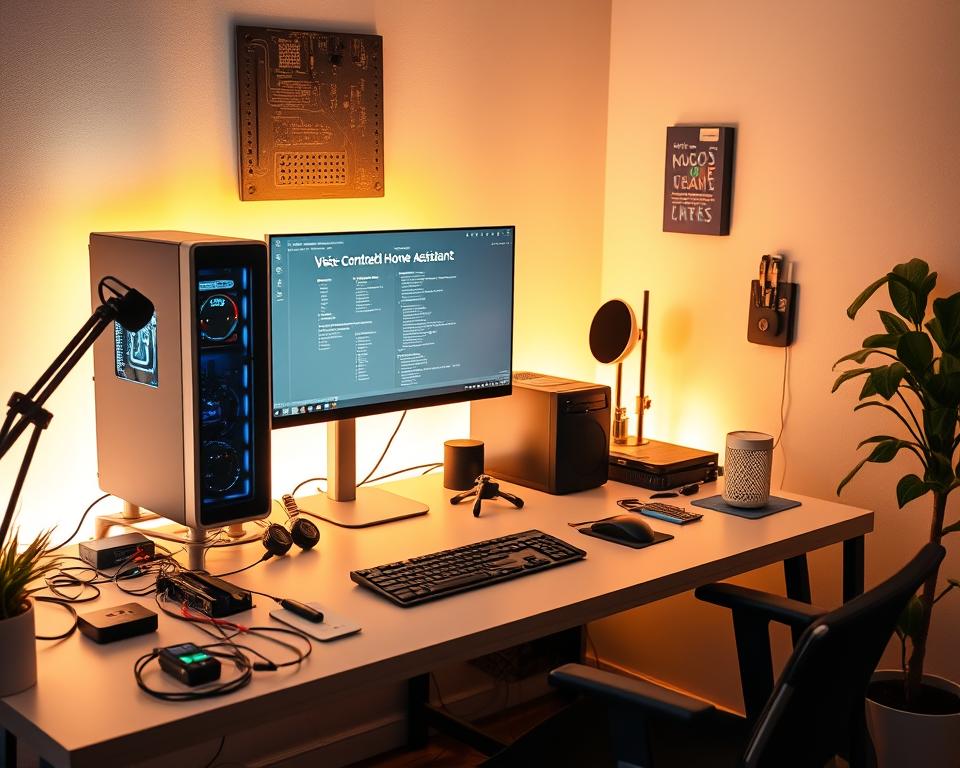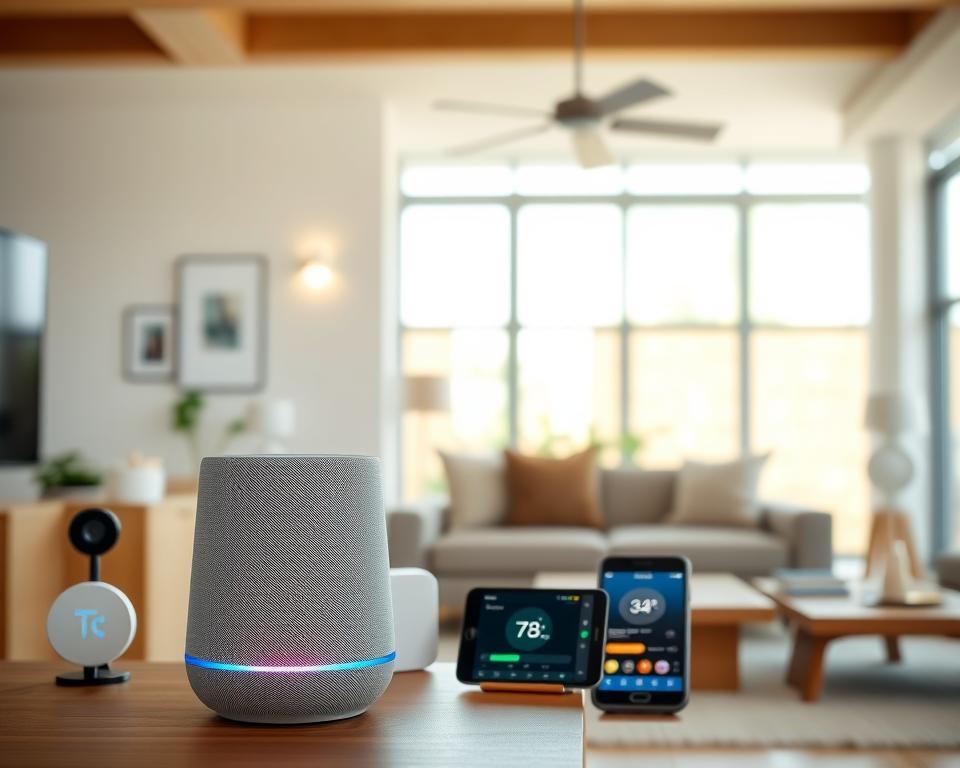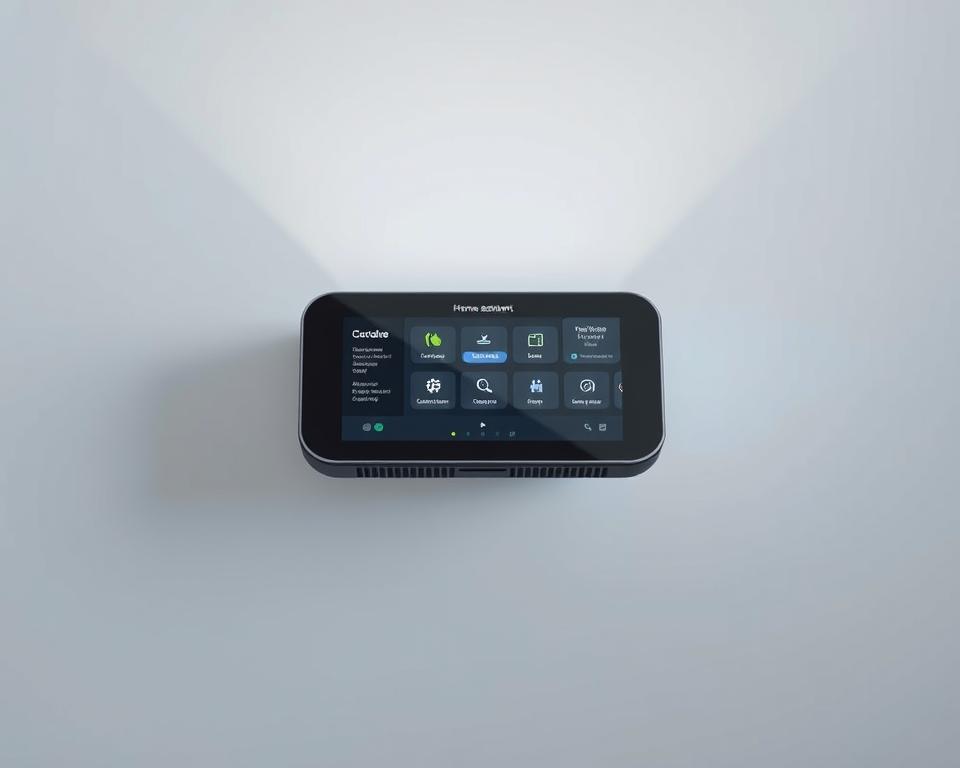To make a voice-controlled home assistant app like Alexa, you need to know a lot about voice recognition and natural language processing. These technologies let users easily talk to their smart home devices. This makes smart home integration a reality. With more people using voice-controlled tech, it’s key to create apps that get voice commands right.
Developers can make apps more user-friendly by using voice recognition and natural language processing. This guide will show you how to build a voice-controlled home assistant app. We’ll cover the important parts and tech needed, like natural language processing and smart home integration.
Table of Contents
Key Takeaways
- Creating a voice-controlled home assistant app needs a good grasp of voice recognition and natural language processing.
- Smart home integration is a big part of voice-controlled tech.
- Natural language processing lets users easily talk to their smart home devices.
- Voice recognition is key for making voice-controlled home assistant apps.
- Developers can use natural language processing and voice recognition to make smart home integration easier and more user-friendly.
- A detailed guide is needed to help developers build a voice-controlled home assistant app.
- Knowing the essential components and technologies is crucial for a successful project.
Understanding Voice-Controlled Home Assistant Technology
Voice-controlled home assistants are getting more popular. They work thanks to voice recognition, natural language processing, and AI development and machine learning. These technologies help them understand and act on voice commands.
A voice assistant uses complex algorithms to get what you say. It turns your words into text and then figures out what you mean. Thanks to machine learning, these systems get better with time.
- Voice recognition basics, which turn your words into text
- Natural language processing, which helps them understand your voice commands
- AI and machine learning, which make them smarter and more accurate
Knowing these key technologies helps developers make better voice-controlled home assistants. AI development and machine learning are key. They make voice recognition systems more accurate and efficient.
Essential Hardware Requirements for Your Assistant
Building a voice-controlled home assistant needs the right hardware. Home automation requires a central processing unit, enough memory, and reliable connectivity. The hardware you choose depends on your project’s needs, like how many smart devices you’ll use.
In IoT development, compatibility is crucial. Your hardware must work well with different smart devices, like lights and cameras. A good home automation system lets all devices work together smoothly.
Some key hardware to think about includes:
- A strong central processing unit (CPU) for complex tasks
- Enough memory (RAM) for smooth performance
- Good connectivity, like Wi-Fi or Bluetooth
- A compatible operating system for your IoT development
Choosing the right hardware for your voice-controlled home assistant makes your home automation experience better. It lets you easily control and monitor your smart devices. This makes your life more convenient and comfortable.
Software Architecture and Technology Stack
Building a voice-controlled home assistant requires careful planning. The software architecture and technology stack are key to its success. Choosing the right backend frameworks is crucial for handling voice commands and smart devices. A good database management system is also essential for storing and retrieving data.
Developers have many backend frameworks to choose from, like Node.js, Django, and Flask. Each has its own strengths and weaknesses. The choice depends on the project’s needs. For instance, Node.js is great for real-time apps, while Django is better for complex data-driven projects. To learn more about hiring top backend developers, visit this comprehensive guide.
When designing a database, consider data modeling, schema design, and query optimization. A mix of relational and NoSQL databases can make a system scalable and efficient.
API integration is another important aspect. Developers must think about API design, security, and authentication. Using RESTful APIs and OAuth authentication ensures a secure and efficient system. Benefits include platform independence, scalability, and ease of maintenance.
Setting Up the Development Environment
To start building a voice-controlled home assistant, you need the right tools. This includes development tools, coding languages, and integrated development environments. These will help you begin your project smoothly and ensure quality.
When picking coding languages, think about Python, Java, or C++. They’re popular for voice apps and have lots of libraries. Also, choose integrated development environments like Eclipse or Visual Studio. They offer features like code completion and debugging.
Some top development tools for voice apps are:
- Speech recognition libraries like Google Cloud Speech-to-Text or Microsoft Azure Speech Services
- Natural language processing frameworks like NLTK or spaCy
- Machine learning libraries like TensorFlow or PyTorch
With the right development tools, coding languages, and integrated development environments, you’re ready. You’ll create a voice-controlled home assistant that’s both useful and easy to use.
Voice Recognition API Integration Options
Developers have many choices when adding voice recognition to a home assistant app. Cloud integration is crucial for smooth communication between the app and the voice service. Google Speech-to-Text and Amazon Transcribe are top picks, known for their strong speech-to-text services.
Microsoft Azure Speech Services is another option, offering top-notch voice recognition with cloud integration. The right API depends on the project’s needs, like accuracy and device support.
- How accurate and reliable the service is
- If it works well with different devices and platforms
- The level of cloud integration and scalability
- The cost and pricing model
By weighing these factors and choosing wisely, developers can make a home assistant app that’s easy to use. It will use the full power of voice recognition APIs and speech-to-text services.
Implementing Core Voice Processing Functions
To make a voice-controlled home assistant, you need to add key voice processing parts. This means using audio signal processing and speech recognition to get it to understand and act on voice commands.
Some important ways to do this include:
- Filtering audio signals to remove noise and interference
- Applying machine learning algorithms to recognize patterns in speech
- Using natural language processing to understand the context and intent of voice commands
By using these methods, developers can make a voice-controlled home assistant that works well. It can understand and act on voice commands, making it easy to use for smart home control.
Good speech recognition is key for a voice-controlled home assistant. It lets the device understand and act on voice commands. With advanced audio signal processing and machine learning, developers can make a device that works well, even in noisy places.
In short, adding core voice processing parts is vital for a voice-controlled home assistant. By using the latest techniques and tech, developers can make a device that works well. This makes it a great addition to any smart home system.
Building the Natural Language Understanding System
To make a voice-controlled home assistant, you need a system that gets voice commands right. This system uses natural language understanding to figure out what the user wants. It works with intent recognition and entity extraction to give the right answers.
Building this system takes a few important steps. These include:
- Intent recognition: figuring out what the user wants, like turning on lights or playing music
- Entity extraction: finding out specific details, like a song name or device location
- Context management: knowing the conversation’s context for accurate responses
With these steps, the system offers a smooth and easy user experience. It uses entity extraction and intent recognition to meet the user’s needs. This makes it key for any voice-controlled home assistant.
Developing Smart Home Device Integration
Integrating smart home devices with voice-controlled systems makes life easier. It’s key to know the rules for IoT integration. This lets devices talk to each other and the main hub. With device control, users can manage their smart devices easily, making life more convenient.
One big challenge is making sure all devices work together. Using standards like Zigbee or Z-Wave helps. Also, IoT integration through the cloud lets users control devices from anywhere.
Smart home integration brings many benefits. For example:
- It makes life more convenient and controlled.
- It helps save energy.
- It boosts home security.
By integrating smart home devices, users get a more automated life. They can control many devices with one interface. This makes daily routines simpler and life more comfortable.
Creating Custom Skills and Commands
To make a voice-controlled home assistant better, you need to create custom skills and commands. This means designing a skill architecture that can handle different voice commands. It also needs to give the right responses. This way, users can control their smart home devices like lights, temperature, and entertainment systems more easily.
When making custom skills, think about how to map voice commands to actions. This ensures the commands work smoothly and the assistant responds correctly. For example, a user can say “turn on living room lights” to turn on the lights. The assistant will then send the right command to the smart device.
Best Practices for Custom Skills
- Keep custom skills simple and intuitive to use
- Use natural language processing to improve voice command recognition
- Implement robust response handling to handle various user queries
By following these tips and creating custom skills, users can make their smart home experience better. They can control their devices more naturally with voice commands. This makes using smart home devices more enjoyable and convenient.
Also, custom skills can work with many smart devices. This lets users control several devices with just one voice command. This integration makes managing a smart home easier and more efficient. It allows users to enjoy their smart home more.
Implementing Security and Privacy Features
When making a voice-controlled home assistant, keeping user data safe is key. Security features are vital to prevent unauthorized access. Voice authentication checks who’s using the assistant by their voice. This makes sure only the right people can use it.
Data encryption is also crucial. It makes user data unreadable to keep it safe from hackers. Strong encryption builds trust with users. Important steps for security include:
- Secure communication protocols
- Safe data storage
- Following privacy laws
By focusing on security features, voice authentication, and data encryption, developers make a safe assistant. This keeps user data safe and makes the assistant more reliable.
Designing the Wake Word Detection System
Creating a wake word detection system needs careful thought on speech recognition and voice activation. It must accurately pick up the wake word. This lets the voice-controlled home assistant listen for commands. For this, developers can use the wake word detection guide from Home Assistant.
Some important things to think about when designing this system include:
- Choosing the right wake word: It should be unique and easy to recognize.
- Using speech recognition algorithms: They need to work well in different places and with various accents.
- Optimizing for voice activation: The system should quickly and accurately find the wake word for smooth voice activation.
By focusing on these points and using the right methods, developers can make a system that works well. This is key for a voice-controlled home assistant. It lets the device wake up and listen for commands.
Following best practices and using the right tools helps developers make a system that’s both accurate and efficient. This makes voice-controlled home assistants more convenient and easy to use. The use of wake word detection and speech recognition technologies improves these devices a lot.
User Interface and Experience Design
Making a voice-controlled home assistant easy to use is key. This includes Amazon’s Alexa or Google Assistant. The
user interface
should blend
voice feedback mechanisms
, visual parts, and
accessibility considerations
for a great user experience.
Voice feedback, like clear and natural responses, builds trust. It helps guide users through their interactions. The visual interface, with status indicators and touch controls, should work well with voice interactions. This creates a full experience.
Features like screen reader support and closed captions make the assistant accessible to all. This ensures it’s inclusive for everyone. By focusing on accessibility, you make the experience better for everyone.
A well-designed
user interface
and clear
voice feedback
make your home assistant essential. It boosts users’ productivity, convenience, and happiness.
section>







